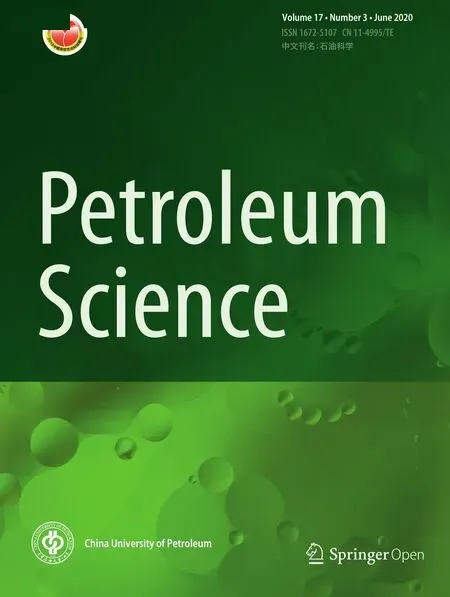Challenges in developing polymer flocculants to improve bitumen quality in non‑aqueous extraction processes: an experimental study
Daniel V. Dixon · Stanislav R. Stoyanov · Yuming Xu · Hongbo Zeng · João B. P. Soares
Abstract Western Canada’s oil sands hold the third-largest hydrocarbon deposits in the world. Bitumen, a very heavy petroleum, is currently recovered by surface mining with warm water or in situ. Recovery processes that use organic solvents are being developed to reduce water usage and tailings production. While solvent-based methods can effectively extract bitumen,removal of residual fine solids from diluted bitumen product (DBP) to meet the pipeline transport requirement of < 0.5 wt%solids and water in DBP remains a major challenge. We propose a novel area of application of polymer flocculants for fine solids removal from DBP. In principle, polymer flocculants can be applied to help remove these residual solids in conjunction with physical separation processes to increase process effectiveness and energy efficiency. Several polymers are selected and screened for flocculation behavior using kaolinite suspended in DBP and toluene, as a model system. Focused beam re flectance measurements and force tensiometer techniques are used to determine flocculation and sedimentation in DBP.The observed flocculation and sedimentation rate enhancements indicate that the polymers tested have only minor effects,providing opportunities for advanced polymer development. These findings exemplify the challenges in identifying polymers that may be effective as flocculants in heavy petroleum media.
Keywords Non-aqueous extraction · Diluted bitumen · Oil-soluble polymer flocculants · Sedimentation in dark and opaque media · Focused beam re flectance measurements
1 Introduction
For several decades, bitumen has been extracted from oil sands in Alberta by surface mining using variations of the modi fied Clark hot water extraction process (Clark and Pasternack 1932). This process is energy intensive, as up to 10 volumes of water need to be heated per volume of bitumen produced. The process also yields fluid fine tailings (FFT)that are currently stored in tailings ponds for decades and must undergo further intensive dewatering before the solids can be reclaimed as a dry landscape. Recent estimates show that tailing ponds (including dykes, berms, and beaches)already occupy over 220 km2of land in Alberta (Lower Athabasca Region 2015). The remediation of tailings ponds is an area of active research, with polymeric flocculants being used in most commercial tailings treatment technologies (Botha and Soares 2015; Vedoy and Soares 2015).
Alternatives to the modi fied Clark process are actively being investigated, with the aim of reducing energy and water usage. Of particular interest are non-aqueous bitumen extraction processes based on organic solvents intended to eliminate water use and long-term tailings storage (Lin et al.2017). Non-aqueous extraction processes, however, face challenges in solvent recovery and solids migration to the bitumen product (Lin et al. 2017). Process aids, such as polymers, are one approach that may improve the efficiency of non-aqueous bitumen extraction processes (Lin et al. 2017).
Both commercial extraction processes and pilot-scale non-aqueous extraction processes currently require an additional solids removal step before the bitumen product can be transported by pipeline (Rao and Liu 2013; Lin et al. 2017).The use of polymers as flocculants in organic media and in oil applications, have been, to the authors’ knowledge,largely underexplored as a means of flocculating solids in these media, with previous studies being restricted to model systems (Ngnie et al. 2018).
Polymer flocculants have been used successfully to remove solids at lower energy costs than mechanical separations in waste water treatment, mineral processing, pulp and paper (Gregory and Barany 2011) as well as in treatment of FFT from oil sand mining operations. Process aids consisting mainly of polyacrylamides (PAMs) have been investigated to improve the overall processing of low-grade ores(Li et al. 2005, 2008; Long et al. 2011). Polymers are used in bitumen froth treatment as demulsi fiers to facilitate the coalescence of water droplets and allow for bitumen–water phase separation (Ese et al. 2000; Wu et al. 2005; Pensini et al. 2014; Tchoukov et al. 2014). Typically, polymer flocculation involves the adsorption of a polymer onto the surface of colloidal particles, where it can then act as a bridge between particles, resulting in aggregation and destabilization of the suspension. The flocculation process is sometimes enhanced via charge neutralization if the polymer subunits and the particles are oppositely charged (Szilagyi et al.2014; Vedoy and Soares 2015). Higher-molecular-weight polymers improve particle settling rates due to the formation of longer/multiple bridges between mineral particles. Most flocculation applications call for water-soluble polymers and polyelectrolytes that are insoluble in bitumen. However, the principles of aqueous flocculation should be applicable for the development and optimization of oil-soluble polymer flocculants for the removal of fines from diluted bitumen products (Napper 1968; Ngnie et al. 2018).
Of particular interest are polymer flocculants that have been used in the oil sands industry to treat FFT and mature fine tailings (MFT), a topic covered in recent reviews (Vedoy and Soares 2015; Vajihinejad et al. 2019). Most flocculants used to treat FFTs are derived from PAMs, which can by synthesized as neutral, anionic, or cationic polymers (Long et al. 2006; Li et al. 2015; Lu et al. 2015, 2016a, b; Vedoy and Soares 2015; Reis et al. 2016; Botha et al. 2017; Zhu et al. 2017). This flexibility has allowed PAMs to be used in a variety of systems that may require different charge characteristics. Additionally, PAMs can be synthesized with exceptionally high molecular weights (> 106g/mol),which makes these polymers even more effective as bridging flocculants (Gregory and Barany 2011; Vedoy and Soares 2015). In polymer applications for flocculation of solids out of bitumen, a major challenge would be to select polymers that adsorb on mineral solids but that are also soluble in oil.
2 Polymer flocculant selection
Many of the properties that make a demulsi fier surfaceactive are analagous for polymer flocculants. Surface-active components are required for efficient adsorption of the polymer chains onto the clay particle surfaces. However, unlike demulsi fiers, flocculants must be composed of long polymer chains so that the free end of an adsorbed polymer molecule may attach to other particles and form large flocs (Dickinson and Eriksson 1991). To meet the requirement of less than 0.5 wt% solids and water in diluted bitumen, the ideal flocculant must be soluble in diluted bitumen, form dense flocs with mineral solids that will settle out of the bitumen phase,preferentially adsorb to clay and other mineral particles over bitumen, and lead to a sediment that dries easily. The latter characteristic would minimize the retention of solvent in the settled solids. Ideally, this should be accomplished at the lowest possible dosage and material cost.
Intermolecular interactions are central to understanding how solids migrate into bitumen and how polymer flocculants operate. To better understand the hierarchy of intermolecular forces acting in these systems, further knowledge of the chemical structures of the solids and polymer flocculant,and of solvation thermodynamics is needed. Electrostatic and dispersion forces play key roles in interactions among the system components. Moreover, an understanding of the mechanism of formation of polymer bridges between particles and the forces that arise due to the bridging interactions,as well as the mixing energy in the system, are required in order to describe the interactions in the system (Dickinson and Eriksson 1991).
Polymer bridging is the process by which a polymer molecule adsorbs onto one particle, and then a tail or loop of the adsorbed polymer adheres to other particle(s). If the bridging force is sufficient, the particles will remain in close proximity and form a floc that can then settle out of the mixture. Attractive bridging forces have been measured for polymer flocculants used in tailings treatments (Lu et al. 2015, 2016b; Wang et al. 2015). While bridging is the main mechanism for polymer-mediated flocculation, electric double-layer forces may also play a signi ficant role for electrostatically stabilized suspensions.These suspensions can often be flocculated through charge neutralization, electrostatic patching, or in combination with polymer bridging (Dickinson and Eriksson 1991).For these cases, polyelectrolytes are the most useful additives because they interact strongly with charged particles that need to be separated. Adsorbed polymers are more likely to stay attached to an oppositely charged surface,and the net surface charge of the polymer-coated surfaces may be neutralized at the right dosage of polyelectrolyte.Complete coating of a charged particle with an oppositely charged polymer is not necessary for flocculation. If only patches of opposite charge are formed, the enhanced electrostatic attraction between the particles may still create better opportunities for polymer bridging (Gregory 1973;Dickinson and Eriksson 1991).
Electrostatic effects are prominent in aqueous solutions,where ions are readily soluble and hydronium cations may freely dissociate from some functional groups, stabilized by water and free ions. This is not the case in nonpolar solvents, where the dielectric constants are very low (~ 0.2).As a result, in nonpolar media, electrostatic interactions typically play a smaller role compared to other interactions such as polymer bridging, steric forces, and hydrophobic interactions (Morrison 1993; Berg 2010).
The choice of solvent can have a signi ficant effect on the stability of a mineral suspension and the performance of a polymer flocculant. The interactions among polymer,solids, solvent, and the interfacially active components of bitumen, such as asphaltenes, all contribute to flocculation performance. Toluene is considered a good solvent for asphaltenes, the component of bitumen that is known to stabilize emulsions and suspended solids (Marlow et al.1987). In toluene-based systems, asphaltenes at surfaces create a repulsive steric barrier between particles due to the swelling of the asphaltene layer (Wang et al. 2009;Natarajan et al. 2011). In the presence of heptane, a poor solvent for asphaltenes, the asphaltene layers are not extended and there is only a small attractive force between asphaltene-coated surfaces (Natarajan et al. 2011).
Moreover, the choice of solvent in the diluted bitumen would have a substantial effect on the thermodynamics of polymer adsorption. As described by the mean field theories of polymer adsorption, and the Flory–Huggins solution theory, the quality of the solvent can affect the conformation of polymers and the energetic driving force behind adsorption. For good flocculation performance, the polymer would need to outcompete adsorption of both solvent and bitumen components that may also interact with mineral surfaces.
When choosing a class of polymers to work with, the use of solubility parameters may be helpful in guiding the selection of materials that are compatible with bitumen–solvent mixtures. The solubility parameter, first introduced by Hildebrand and Scott, is derived from the cohesive energy density of a pure substance and estimated using the following equation (Hansen 2007):

whereδis the Hildebrand solubility parameter,ΔHvis the enthalpy of vaporization,Ris the gas constant,Tis the absolute temperature, andVis the molar volume. According to this theory, materials having similar solubility parameters are miscible with one another. This theory is limited when it comes to polymers because the enthalpy of vaporization cannot be measured in polymeric materials, as they degrade when heated. The solubility parameters of polymers can be calculated by indirect methods based on solvent testing, swelling values, refractive index, intrinsic viscosity, or inverse gas chromatography. These can still serve to qualitatively predict behavior or guide experiments.
When selecting solvents for the extraction of bitumen,Pal et al. (2015) and Nikakhtari et al. (2013) have come to close agreement on what solubility parameter would be ideal for solvent–bitumen mixtures. Pal et al. (2015)determined that the solvent solubility parameter should fall between 16.45 MPa1/2and 16.65 MPa1/2to minimize fines in bitumen, and Nikakhtari et al. (2013) determined that solubility parameters above 16.5 MPa1/2are best to reduce fines migration into bitumen. A polymer selected in this range may also be soluble in diluted bitumen. Some polymers in this range include polyethylene (16.2–16.6 MPa1/2),polyisoprene (15.8–16.68 MPa1/2), and polyisobutene(16.06–16.47 MPa1/2) (2007). These polymers all fall under the class of polyole fins and have been used widely in the oil industry as drag reducers for pipelines. They share some characteristics with the desired attributes of polymers for flocculation of fine solids in the bitumen extraction process,namely they should be of high molecular weight (greater than 106g/mol), amorphous, and readily soluble in oil(Mowla and Naderi 2006).
A purely oil-soluble hydrophobic polymer, however, cannot be used in flocculation applications, because the polymer would favor remaining in the bulk oil phase instead of adsorbing onto clay or other mineral solids. These solids are negatively charged in water and would still be partially negatively charged in bitumen, because clays could retain some water from the oil sand ore. Therefore, the target polymer flocculant would also require some polar end groups or blocks of hydrophilic polymer to facilitate adsorption onto fine solids. Figure 1 illustrates some possible arrangements of hydrophilic and hydrophobic monomers. Systems, such as hydrolyzed polyethylene (Botha et al. 2017), blocks of PEO/PPO (Pensini et al. 2014; Reis et al. 2016), or temperatureresponsive changes in hydrophobicity (Long et al. 2011; Lu et al. 2015), have all been used in the treatment of mineral tailings and have the potential to work in the removal of solids from bitumen in a non-aqueous extraction process.
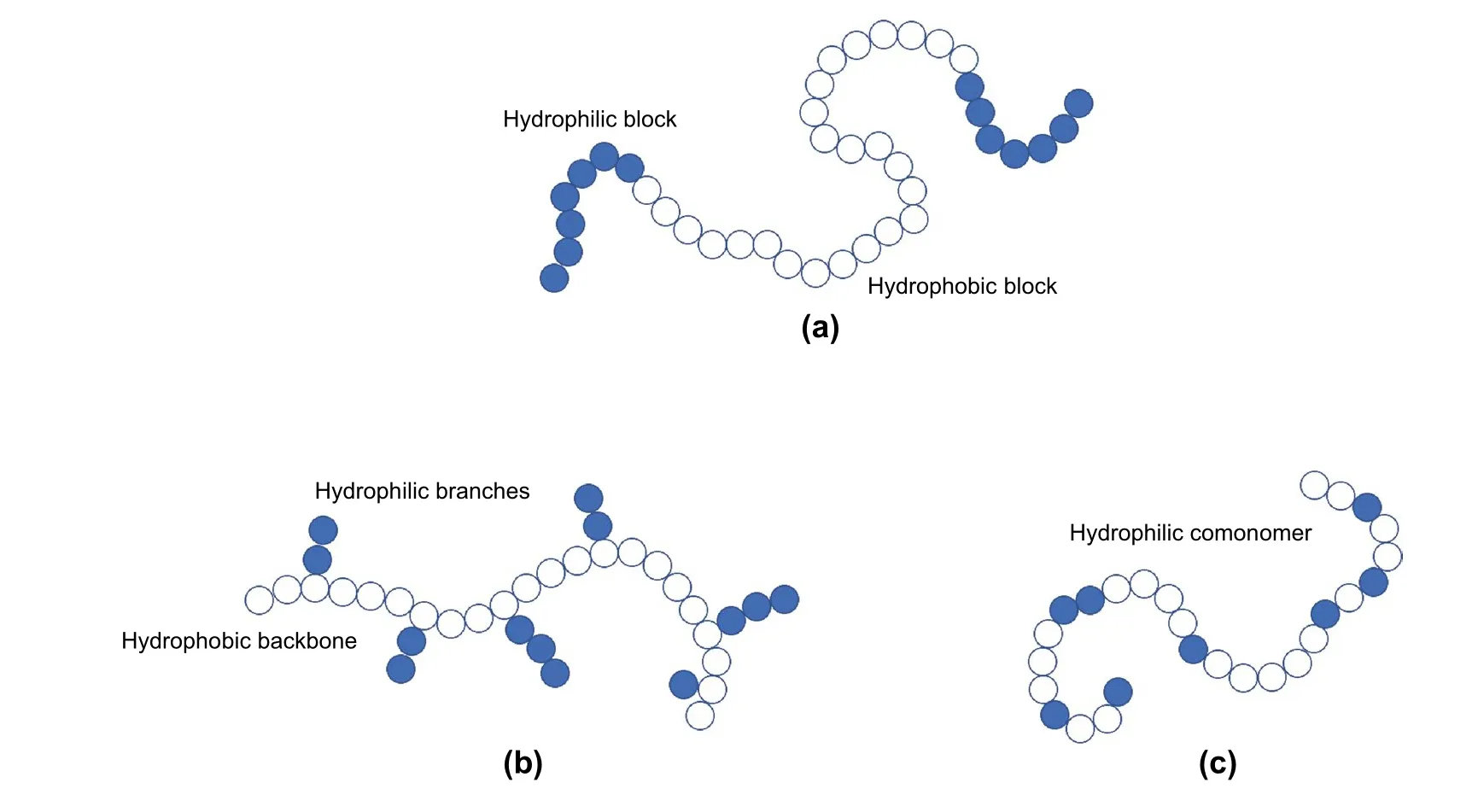
Fig. 1 Schematic diagram of possible polymer flocculant structures. a Block copolymer with hydrophobic chain and hydrophilic chain ends. b Hydrophobic polymer with hydrophilic branches. c Random copolymer with hydrophobic and hydrophilic monomers
Herein, we explore the challenges faced when developing polymer flocculants to improve bitumen product quality and support the industrial implementation of non-aqueous recovery processes. An evaluation of several flocculant systems for solids removal is presented in the context of the challenges of observing fine solids settling in dark bitumen media. Moreover, criteria for the design of polymer flocculants to settle fine particles out of diluted bitumen are outlined, based on knowledge gained from the use of flocculants in different stages of the modi fied Clark process.
3 Materials and methods
3.1 Materials
Organic solvents used in this study, toluene and cyclohexane, were purchased from Sigma-Aldrich and used without further puri fication. Kaolinite was purchased from Acros Organics. Bitumen, free of solids, was obtained from an oil sands operator and used as is. Ethyl cellulose, poly(ethylene glycol)-block-poly(propylene glycol)-block-poly(ethylene glycol) (Mn~ 5800), (hydroxypropyl)methyl cellulose, poly(ethylene oxide) (Mw~ 1 M),polystyrene (Mw~ 350,000), methyl acrylate, amylopectin, and hydroxyethyl cellulose were purchased from Sigma-Aldrich. Hyperbranched functionalized polyethylene (HBfPE) (5% methyl acrylate) was synthesized in our group, as described elsewhere (Botha et al. 2017).Polystyrene sulfonate was modi fied according to the procedure detailed in Mazzeo et al. (Mazzeo et al. 2018).
Ethylene–propylene–diene terpolymers (EPDM) (3%–6%diene content) were supplied by DOW Chemical Co., and modi fied using 9-borabicyclo[3.3.1]nonane and hydroxylated with NaOH/H2O2(Chung et al. 1994).
3.2 Solubility screening
Polymer solubility was determined qualitatively based on cloud point observations at room temperature, at concentrations of 2 mg/mL (Mazzeo et al. 2018). Both toluene and cyclohexane were used as solvents to screen the viability of the polymer flocculants. Initially, the polymer solutions were mixed for up to 24 h at room temperature. If the polymer appeared insoluble, or if the solution remained cloudy, the temperature was raised to 50 °C and stirred for an additional 24 h. All solutions were cooled to room temperature before final observations were made.
3.3 Preparation of model suspensions
Kaolinite particles were prepared as a 2% w/w suspension in bitumen/toluene solution (10% w/w). This mixture was stirred at room temperature overnight at 250 rpm to ensure sufficient adsorption of bitumen on the kaolinite particles. The suspensions were then sonicated for 1 min and mixed again for an additional 30 min. These suspensions were then used in particle size and sedimentation measurements.
3.4 FBRM monitoring
Focused beam reflectance measurement (FBRM) is an optical technique for the characterization of particle sizes(chord lengths). It is useful for in situ monitoring of particles ranging in size from 1 μm to 1 mm. The technique relies on the re flectance of a laser light and thus can be used in dark or highly concentrated solutions, where absorbance or light scattering measurements are typically unreliable.In oil sands applications, the FBRM technique has been successfully used for the characterization and performance measurement of a number of flocculants used for mature fine tailings treatments (Gumfekar and Soares 2018; Vajihinejad and Soares 2018).
Model suspensions were prepared and used for chord length distribution monitoring. The suspensions were mixed at 200 rpm in a 250 mL beaker and monitored in real time with an FBRM probe. The polymer was added as a 2 mg/mL solution in toluene to the suspension under the same mixing conditions, and the chord length distribution of the particles were continuously recorded, as the polymer dose was increased from 500 mg polymer/kg solids up to 50,000 mg polymer/kg solids.
3.5 Sedimentation
A Krüss K100 force tensiometer with a sedimentation probe–a highly sensitive balance with a probe immersed in the solution where particles can accumulate on a dish–was used to measure mass accumulation over time. This technique has proved useful to monitor the sedimentation of silica microparticles in aqueous solutions and in organic media treated with bitumen (Gupta and Basu 2005; Karkooti 2014). Model suspensions were transferred to a dish in the force tensiometer and polymer was then added to the suspension under constant mixing for 1 min before mixing was stopped, and the sedimentation probe was immersed in the suspension to monitor mass accumulation. Figure 2 depicts the experimental setup.
4 Results and discussion
4.1 Polymer solubility evaluation
The polymers in Fig. 3 were first evaluated for solubility in toluene and cyclohexane. A viable polymer for flocculation needs to be readily dispersible in diluted bitumen at operating temperatures. The first candidate was a recently developed HBfPE, a polyethylene copolymerized with methyl acrylate having a hyperbranched structure (Botha et al. 2017). This polymer was selected, because it had been developed as a flocculant to treat MFT and, being polyethylene-based, would be more easily soluble in oil.The HBfPE used to treat MFT had a methyl acrylate content above 35%, to allow for dispersion in water, but for an oil-soluble variant a lower methyl acrylate content was desired. Analogous to HBfPE, where a hydrophobic polymer was functionalized with a more hydrophilic monomer, a second type of polymer based on the synthetic rubber EPDM was modi fied to add hydroxyl functionality (EPDM-OH).A third type of polymer chosen for screening was a triblock poly(ethylene oxide)–poly(propylene oxide)–poly(ethylene oxide) (PEO–PPO–PEO). Polymers of this class are used as surfactants and demulsi fiers. In fact, many PEO–PPO–PEO linear and star polymers are used in oil sands froth treatment to break emulsions (He et al. 2015). Our hypothesis was that the surface-active nature of these polymers and the ability to tune their hydrophobicity by changing the ratio of PEO to PPO could make them good candidates if they could be synthesized with sufficiently high molecular weights. Poly(methyl acrylate) (PMA) homopolymer was also tested for solubility. PMA has been used as part of grafted copolymers of PAMs and EPDMs, as mentioned above. This screening was conducted to determine if the PMA homopolymer could act as a flocculant in this system.Poly(styrene sulfonate) (PSS) was also tested with 7% of the sub-units sulfonated. Polystyrene is oil soluble, and its sulfonated derivative is highly charged, improving solubility in water at high degrees of sulfonation; at low degrees of sulfonation the polymer remains soluble in toluene. A number of natural polymers that have been used in the oil industry as demulsi fiers–ethyl cellulose (EC), hydroxypropyl methyl cellulose (HPMC), amylopectin (AMP), and hydroxyethyl cellulose (HEC)–were also included in these screening experiments (He et al. 2015).
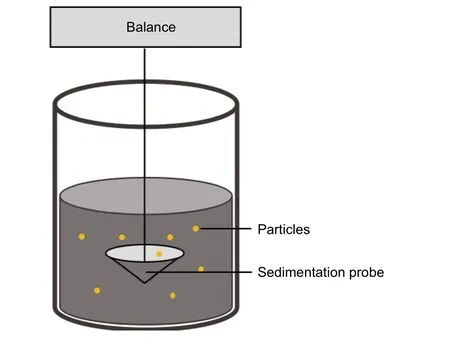
Fig. 2 Schematic diagram of force tensiometer with sedimentation probe
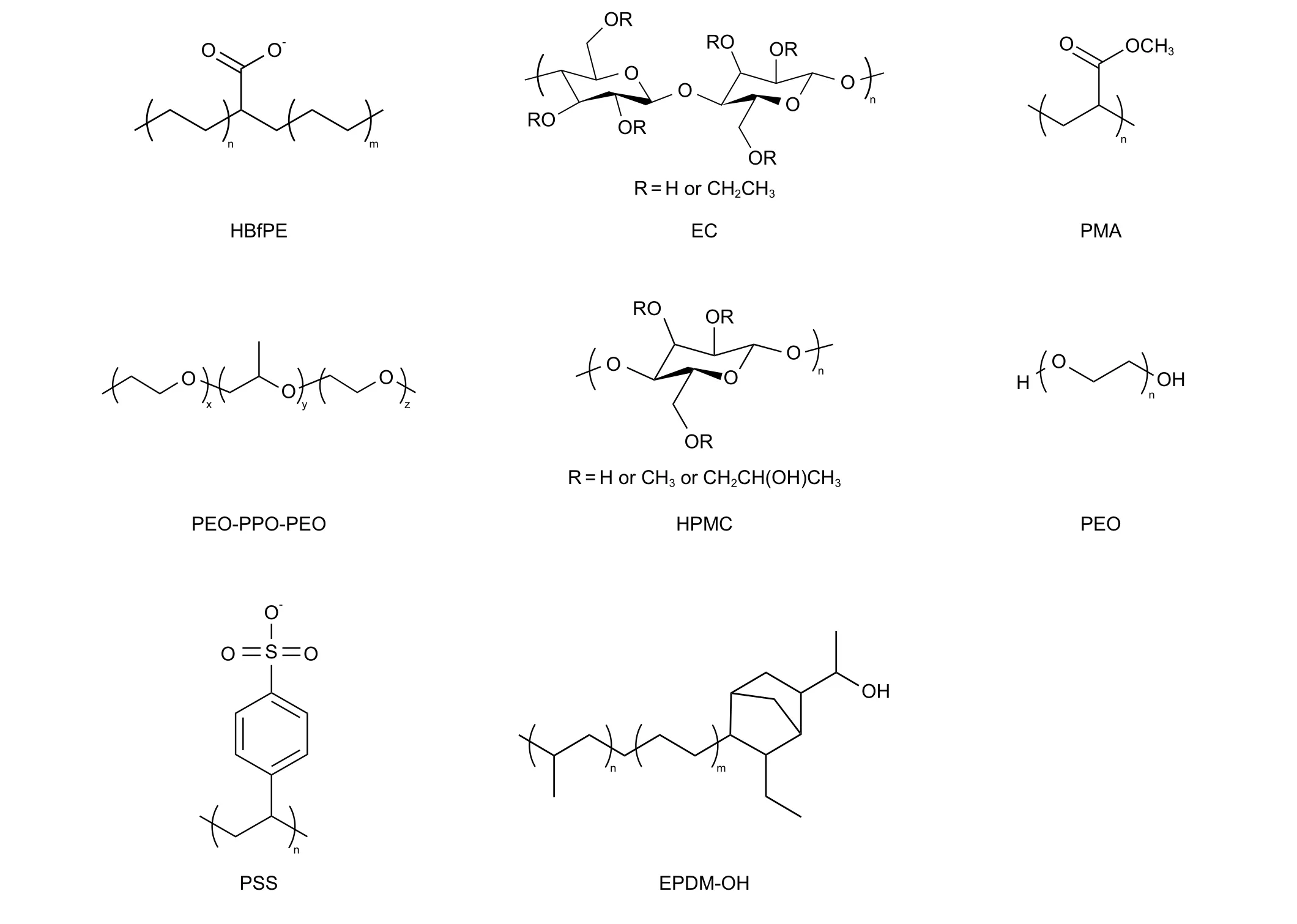
Fig. 3 Polymer structures for the screening experiments: HBfPE hyperbranched functionalized polyethylene, EC ethyl cellulose, HPMC hydroxypropyl methyl cellulose, PMA poly(methyl acrylate), PSS polystyrene sulfonate, EPDM-OH hydroxylated ethylene propylene diene,PEO–PPO–PEO poly(ethylene oxide)–poly(propylene oxide)–poly(ethylene oxide) and PEO poly(ethylene oxide)

Table 1 Solubility of 2 mg/mL of polymer in toluene and cyclohexane
Among these polymers, three were found to be soluble (clear solution at room temperature) in toluene, and five were found to be slightly soluble (cloudy solution at room temperature, but soluble at elevated temperatures)in toluene (Table 1). Only HBfPE was completely soluble in cyclohexane, one of the more effective solvents for non-aqueous extraction processes (Nikakhtari et al. 2013).These findings further demonstrate the challenge in identifying polymers that may be effective in oil-based media.Even at low degrees of polar functionalization, many of the tested polymers become difficult to disperse in toluene and are insoluble in cyclohexane. The eight toluene-soluble polymers were used in further tests to evaluate the flocculation and sedimentation of kaolinite using the FBRM and force tensiometer techniques.
4.2 Chord length distribution monitored via FBRM
Figure 4 presents the chord length distribution of kaolinite particles used for flocculation screening determined using FBRM. Kaolinite is the most common clay material found in bitumen (Kaminsky et al. 2009), so screening for its flocculation was used as a starting point in this comparative investigation.
Kaolinite particles have a bimodal chord length distribution, which is consistent with the laser diffraction data.The FBRM measurements done in toluene show that kaolinite exists in larger aggregates compared to the kaolinite samples measured in water (Fig. 4). This observation is consistent with the fact that kaolinite is more readily dispersible in water, where the clay can more readily participate in hydrogen bonding with water. In nonpolar solvents,the kaolinite particles would more likely be attracted to themselves than to the solvent in the system. This phenomenon has been demonstrated in simulations of kaolinite platelets in water, toluene, and cyclohexane. Stronger short-range attractive forces are present in cyclohexane and toluene than in water (Hlushak et al. 2016; Hlushak and Kovalenko 2017). These FBRM results demonstrate that the chord length distribution can be measured under experimental conditions that consist of a dark 10 wt% bitumen solution. Although chord lengths are not the same measure as particle sizes, as determined by conventional laser diffraction techniques (Heath et al. 2002), the trends in the data are the same and allow to demonstrate whether particle aggregation would occur.

Fig. 4 Chord length distribution of kaolinite particles suspended in a 10 wt% bitumen solution in toluene: number-average chord length distribution (blue solid line), square weighted average chord length distribution (orange dashed line) measured using FBRM. Particle size distribution of kaolinite in water: number-average distribution (green dotted dashed line) and volume-average distribution (red dotted line),measured using laser diffraction (LD)
4.3 Flocculation
The polymers that were found to be soluble, or sparingly soluble, in toluene were tested for their flocculation performance at increasing dosages from 500 mg of polymer/kg of solids in suspension to 50,000 mg/kg. If flocculation was to occur, then a shift in the chord length distribution to higher values would be expected. Figure 5 summarizes a sampling of experiments using kaolinite in a 10 wt% bitumen solution in toluene.
All tested polymers failed to flocculate kaolinite as measured by the FBRM probe. This suggests that either no flocculation occurred or, if it did occur, it happened at such low rates that it could not be observed by FBRM. Failure to flocculate could be a result of polymers failing to adsorb onto the clay surface or a failure of adsorbed polymers to act as bridges promoting flocculation. Adsorption tests using FTIR to detect polymer adsorbed on the clay surface were performed to determine whether polymer adsorption was the limiting step, as described in Supplementary Information Figs. S1 and S2. Based on the conducted adsorption screening tests, no polymer was detected on the clay samples after mixing and washing. Alternative techniques to monitor flocculation and polymer adsorption should be used to con firm these findings.
Of the polymers tested, PEO and PMA exhibited a slight decrease in the number of particle counts, as can be seen in Fig. 5. No change in aggregate size was detected, and the mean square chord length remained stable throughout the experiment. We speculate that some particles did aggregate and settle out of solution without being detected by the FBRM, but did not occur in large enough quantities to have any measurable effect on the particle sizes. The use of PEO to aid in the sedimentation of kaolinite in cyclohexane was recently demonstrated (Ngnie et al. 2018). Therefore,this hypothesis has some merit but, at this scale and size of particles, no firm conclusions can be drawn.
Finding a polymer that is both soluble in the desired solvent and that will interact with clays is a fine balance. It appears, from the present work, that the polymers used did not interact appreciably with the hydrophilic clays.
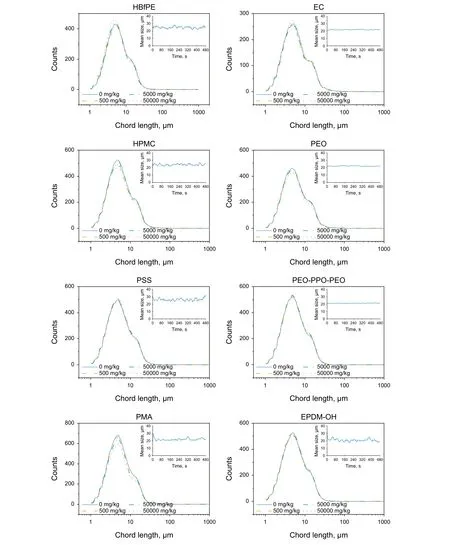
Fig. 5 Chord length distribution (CLD) in bitumen-treated kaolinite suspended in a 10 wt% bitumen in toluene solution, before (solid line) and after (dashed line) polymer addition monitored using the FBRM technique. Insets: Mean square weighted chord length over the course of the experiment
4.4 Sedimentation
Monitoring the sedimentation of solids using a force tensiometer is an alternative method to measure the rate of solids settling out of suspension. This technique is particularly useful because more common optical techniques, such as changes in turbidity or optical density, are limited to mostly translucent solutions. To verify the findings from the FBRM experiments, several flocculation experiments were monitored using the sedimentation probe.
Figure 6 presents the results from mass accumulation measurements over time on the sedimentation probe, in the presence of PSS or HBfPE in doses of 5000 ppm. The slopes showing the initial and final sedimentation rates with and without polymer addition are very similar. The initial settling rates are 0.04 ± 0.01 mg/s for HBfPE and 0.06 ± 0.01 mg/s for kaolinite and PSS. Steady rates of 0.013 ± 0.003 mg/s for HBfPE, 0.014 ± 0.004 mg/s for PSS, and 0.016 ± 0.004 mg/s for kaolinite are measured after 2 min. The results show that the rate of mass sedimentation is not altered to a statistically signi ficant extent.
None of the polymers screened conclusively indicate the occurrence of any aggregation or flocculation of particles in bitumen-rich organic media. The complexity of the bitumen medium makes it difficult to isolate and identify speci fic factors that may have affected the flocculation performance.Predicting structures that are soluble in petroleum and act as flocculants is challenging. Additional fundamental understanding of the clay and bitumen, and how these interact with polymers, would be needed. Some recent experiments have been conducted with polymer-modi fied organo-clays suspended in cyclohexane that indicate flocculation may be possible, but adapting this work to bitumen-rich media would require an extensive effort (Ngnie et al. 2018).

Fig. 6 Sedimentation of kaolinite in a 10 wt% bitumen solution in toluene. Circles: sedimentation with no polymer added. Squares:Sedimentation with 5000 mg/kg polystyrene sulfonate (PSS) added.Triangles: Sedimentation with 5000 mg/kg hyperbranched functionalized polyethylene (HBfPE) added
5 Conclusions
A way to improve the removal of solids from diluted bitumen produced using naphthenic froth treatment and non-aqueous bitumen extraction processes is still desired. Polymer flocculants could help improve the effectiveness of separation of solids from bitumen, reducing the energy required for mechanical separation. Effective polymer flocculants must be hydrophobic for enhanced solubility (or dispersibility in petroleum) and contain polar or charged groups for bonding to fine solid particles. Candidates with potential include hydrophobic polymers with hydrophilic branches,block copolymers containing a main hydrophobic chain with hydrophilic chain ends, and random copolymers containing hydrophilic and hydrophobic monomers. As part of the evaluation of polymer candidates from these types with respect to solubility in hydrocarbon media and flocculation effectiveness, experimental techniques for determination of flocculation and sedimentation in dark and opaque media are identi fied. Observations show that the polymers tested do not exhibit notable flocculation effects on kaolinite in toluene, highlighting the challenges arising from the polymer selection requirements and demonstrating that signi ficant rethinking is needed on how to develop polymer flocculants for non-aqueous media.
Developing new polymers to address the removal of fine solids from diluted bitumen is a potentially signi ficant opportunity. A new class of oil-soluble polymer flocculants would facilitate the flocculation and sedimentation of solids out of the bitumen phase. In addition to being bitumen-soluble, the polymer flocculants must be able to extend in the diluted bitumen in order to bind and bring together multiple fine particles to form dense flocs. Polymer compositions and structures containing an oleophilic backbone for enhanced solubility in bitumen and hydrophilic functional groups for binding to solids would be of interest. A fundamental understanding of how polymer flocculants would behave in complex mixtures of bitumen, solvent, and mineral solids is a non-trivial challenge that offers the opportunity to effectively guide the development of the polymer structure and composition. Such understanding could also bene fit the optimization of existing bitumen extraction processes.
Open AccessThis article is licensed under a Creative Commons Attribution 4.0 International License, which permits use, sharing, adaptation, distribution and reproduction in any medium or format, as long as you give appropriate credit to the original author(s) and the source,provide a link to the Creative Commons licence, and indicate if changes were made. The images or other third party material in this article are included in the article’s Creative Commons licence, unless indicated otherwise in a credit line to the material. If material is not included in the article’s Creative Commons licence and your intended use is not permitted by statutory regulation or exceeds the permitted use, you will need to obtain permission directly from the copyright holder. To view a copy of this licence, visit http://creat iveco mmons.org/licen ses/by/4.0/.
- 石油科学通报的其它文章
- Thermal maturity evaluation using Raman spectroscopy for oil shale samples of USA: comparisons with vitrinite re flectance and pyrolysis methods
- Light hydrocarbon geochemistry: insight into oils/condensatesfamilies and inferred source rocks of the Woodford–Mississippian tight oil play in North‑Central Oklahoma, USA
- Deep‑water depositional architecture and sedimentary evolution in the Rakhine Basin, northeast Bay of Bengal
- A two‑step method to apply Xu–Payne multi‑porosity model to estimate pore type from seismic data for carbonate reservoirs
- Nonlinear amplitude versus angle inversion for transversely isotropic media with vertical symmetry axis using new weak anisotropy approximation equations
- Numerical simulation and dimension reduction analysis of electromagnetic logging while drilling of horizontal wells in complex structures

